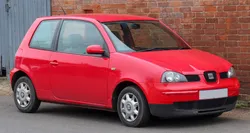

Seat Arosa Generation 1 Overview
Explore the Seat Arosa Generation 1, a compact car known for its efficiency and style. Discover more about this model in Portugal, including specifications and features.
The SEAT Arosa Generation 1 made its debut in 1997, becoming a defining model for the brand during the late 1990s and early 2000s. Its introduction represented SEAT’s commitment to compact, affordable urban mobility, cat...
Technical Specifications
Select Version
Dimensions
Engine
Driving
Others
History and Features
Mycarro AI
Apr 27, 2025
The SEAT Arosa Generation 1 made its debut in 1997, becoming a defining model for the brand during the late 1990s and early 2000s. Its introduction represented SEAT’s commitment to compact, affordable urban mobility, catering particularly to younger drivers and urban dwellers seeking practical and economical transportation solutions. This model was particularly significant as it was SEAT's first independent product since becoming a member of the Volkswagen Group in 1986, showcasing the blend of style, technology, and functionality that would become synonymous with the brand.
Design and Style
The SEAT Arosa was designed with a focus on compactness and functionality. Measuring around 3.5 meters in length, it was one of the smallest cars available on the market at the time. This compact design made it exceptionally maneuverable, perfect for navigating crowded city streets. Its rounded edges and bold front-end design were modern for the late 1990s, giving it an appealing aesthetic that resonated with the target demographic. The interior space, carefully optimized, offered room to comfortably seat four adults, with the rear seats capable of folding down to increase cargo capacity, demonstrating a practical approach to urban driving.
Engine Options
Under the hood, the Arosa offered a variety of engine options to cater to different driving preferences and needs. Customers could choose from a 1.0-liter three-cylinder engine or a 1.4-liter four-cylinder engine, both delivering a balance of sufficient power for city driving and remarkable fuel efficiency. The 1.0-liter model was particularly popular among urban drivers, as it provided an economical choice without sacrificing performance. With engine outputs ranging from approximately 50 to 100 horsepower, depending on the variant, the Arosa proved to be agile and fun to drive, especially on city roads.
Technological Features
The SEAT Arosa Generation 1 was equipped with several technological advancements for its time. Customers appreciated features such as power steering, anti-lock braking systems (ABS), and optional air conditioning. While it didn't boast the plethora of infotainment features seen in modern vehicles, the Arosa did include basic radio systems and optional CD players, appealing to the youthful and creative market of the late '90s. The model's simple technological setup ensured reliability, making it a favorite for first-time car buyers.
Safety and Performance
Safety was a key consideration in the development of the Arosa. The model was designed with multiple crumple zones and reinforced structures, ensuring a strong performance in crash tests. While it may not have received all the latest safety ratings compared to larger vehicles, it still provided peace of mind for urban drivers, particularly in terms of its size, which allowed better visibility and maneuverability in urban settings. Furthermore, its lightweight construction contributed to enhanced fuel efficiency and responsive handling.
Market Impact
Upon its launch, the SEAT Arosa Generation 1 captured a substantial share of the market, positioning itself as a competitive alternative to city cars like the Fiat Uno and the Volkswagen Lupo. Its affordability combined with the backing of the Volkswagen Group’s engineering excellence made it appealing to a diverse range of consumers. The Arosa became synonymous with practical urban transport and played a crucial role in establishing SEAT's reputation as a manufacturer of stylish and approachable compact vehicles.
Legacy
The SEAT Arosa Generation 1 was eventually succeeded by the second generation in 2004, but its legacy as a cornerstone of SEAT’s compact car strategy remains influential. Its design and engineering principles laid the groundwork for many subsequent models within the lineup, including the SEAT Ibiza and the more recent urban SUVs. Today, enthusiasts value the Arosa not just as a city car but as a classic example of 1990s automotive design, with many still on the road as a testament to its durability and timeless appeal.
The SEAT Arosa Generation 1 symbolizes a unique moment in the automotive timeline, one where small cars became credible and stylish options for a new generation of drivers.
